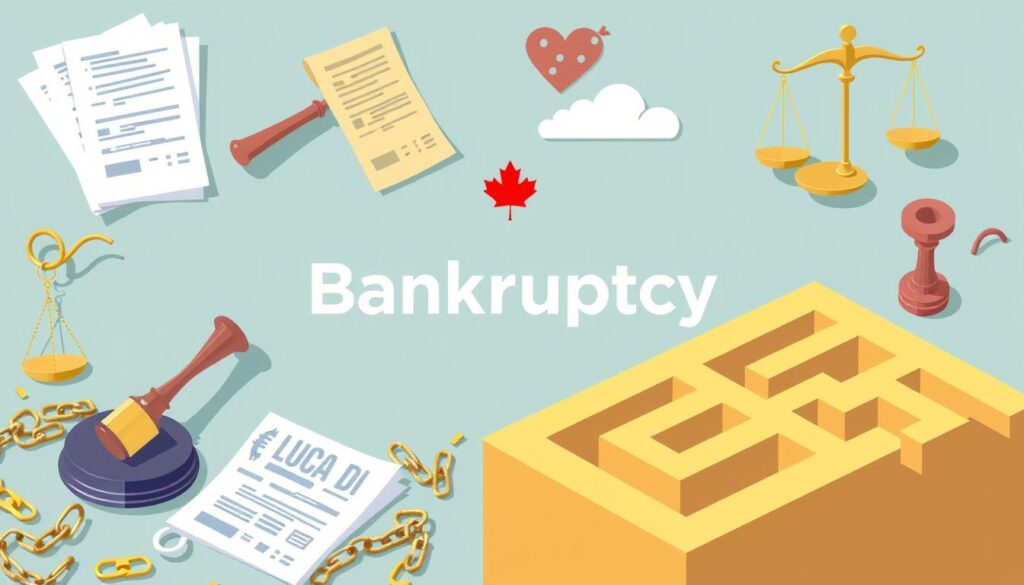Table of Contents
The Bankruptcy and Insolvency Act has been a key part of Canadian law for over 150 years. It offers a safety net for those facing financial trouble. In Alberta, 35% of people worry that rising interest rates could lead to bankruptcy.
This shows how vital it is to know about Bankruptcy and Insolvency Law. It’s also important to get help from a bankruptcy lawyer. They can guide you through the complex process of business bankruptcy.
The Bankruptcy and Insolvency Act is a federal law. It sets out the rules for bankruptcy and insolvency. It makes sure everyone is treated fairly and that the rights of both debtors and creditors are respected.
To declare bankruptcy, you need at least $1,000 in debt. You must be insolvent, meaning you can’t pay your debts. The Act helps debtors find relief, like working with a Licensed Insolvency Trustee to repay debts.
Knowing the Bankruptcy and Insolvency Act helps individuals and businesses deal with financial problems. It’s key to make smart choices about your financial future. If you’re facing bankruptcy, getting help from a qualified lawyer is critical.
With the right help, you can manage your finances better. This leads to a more stable and secure future.
What is Bankruptcy?
Bankruptcy is a legal way to help people who are struggling with debt. It lets individuals or businesses deal with their debts in a new way. In Canada, the Bankruptcy and Insolvency Act (BIA) oversees this process. It helps debtors find solutions before they have to file for bankruptcy.
Definition of Bankruptcy
Bankruptcy is when someone can’t pay their debts and files with a Licensed Insolvency Trustee (LIT). They might make a Consumer Proposal. This means they pay a set amount each month for up to 5 years.
Key Types of Bankruptcy
For individuals, the main types are Chapter 7 and Chapter 13. Chapter 7 means selling assets to pay debts. Chapter 13 is about making a repayment plan. Knowing the difference is key to making the right choice.
Personal bankruptcy can be either Chapter 7 or Chapter 13, based on your situation.
Common Misconceptions
Many people think bankruptcy means you’ve failed. But it can be a way to start over financially. Another myth is that you’ll lose everything. But, some things might be safe from being taken.
In summary, bankruptcy is complex but not always a failure. Knowing about Chapter 7 and Chapter 13 helps you decide. Always talk to a Licensed Insolvency Trustee for the best advice on personal bankruptcy.
What is Insolvency?
Insolvency means someone or a business can’t pay their debts. It’s a wider term than bankruptcy, covering other ways to deal with debt. In Canada, being insolvent means you can’t pay debts on time, have stopped making payments, or don’t have enough assets to cover your liabilities.
Definition of Insolvency
An insolvency attorney can guide you through debt relief. Insolvency might lead to bankruptcy, but it also includes other options like debt consolidation or proposals. Knowing the difference between insolvency and bankruptcy is key to finding the right debt relief.
Differences Between Bankruptcy and Insolvency
The bankruptcy process is complex. It’s important to get advice from an insolvency attorney. In Canada, the Bankruptcy and Insolvency Act (BIA) explains bankruptcy procedures and roles, affecting both debtors and creditors. Key differences between bankruptcy and insolvency include:
- Bankruptcy is a formal process, while insolvency is a state of being unable to pay debts.
- Bankruptcy involves a trustee, while insolvency may involve negotiations with creditors.
- Bankruptcy can wipe out debts, while insolvency might mean repayment plans or debt consolidation.

Getting advice from an insolvency attorney can help you find the best debt relief solution for your situation.
| Debt Relief Option | Description |
|---|---|
| Bankruptcy | A formal process involving the appointment of a trustee and the discharge of debts. |
| Insolvency | A state of being unable to pay debts, which may involve negotiations with creditors or debt consolidation. |
| Debt Consolidation | A process of combining multiple debts into a single loan with a lower interest rate and monthly payment. |
The Importance of Bankruptcy and Insolvency Law
Bankruptcy and insolvency laws are key to the economy. They offer a way to manage debt and help businesses and individuals. In Canada, the government has the power to handle these matters, thanks to the Constitution Act, 1867.
A bankruptcy lawyer helps people and companies deal with debt. Corporate bankruptcies can really affect the economy. This is why changes were made in 2009 to the insolvency laws.
Some important facts about bankruptcy and insolvency include:
- About 75% of insolvencies in Canada are from consumers, with over 94,000 cases in 2020.
- Consumer bankruptcies usually last 9 to 21 months. This depends on if they meet their obligations during that time.
- Business bankruptcies make up around 25% of all insolvencies in 2020. This shows a big impact on businesses.
In summary, bankruptcy and insolvency laws are vital for the economy. They protect consumers and help with debt. A bankruptcy lawyer is key in this process. Understanding corporate bankruptcy is important for both individuals and businesses.
| Year | Number of Insolvencies | Percentage Change |
|---|---|---|
| 2019 | 123,000 | – |
| 2020 | 126,000 | 2.6% |
The Bankruptcy Process
The bankruptcy process has several key steps. These include filing a petition, the automatic stay, and the discharge of debts. Knowing these steps is key to navigating bankruptcy well. In Canada, the Bankruptcy and Insolvency Act (BIA) guides this process, helping debtors, creditors, and Licensed Insolvency Trustees (LITs).
A bankrupt must share earnings and property details with the trustee yearly. This continues until they meet their terms or conditions. The court can grant a discharge certificate, but this can be appealed. It’s important to know that this discharge doesn’t wipe out all debts, like fines or debts from fraud.
People might look into Chapter 7 bankruptcy or Chapter 13 bankruptcy for debt relief. The process starts when a company files for bankruptcy or when creditors ask the court. A Licensed Insolvency Trustee (Trustee) is chosen to oversee the bankruptcy, working alone from creditors.

Corporate bankruptcies in Canada usually last 9 to 12 months. Personal bankruptcies usually take 9 months. It’s vital to understand the bankruptcy process and the options like Chapter 7 bankruptcy and Chapter 13 bankruptcy. This helps make better choices about debt relief.
| Type of Bankruptcy | Description |
|---|---|
| Chapter 7 Bankruptcy | Liquidation of assets to pay off debts |
| Chapter 13 Bankruptcy | Reorganization of debts to create a repayment plan |
Types of Bankruptcy Options
When it comes to personal bankruptcy, individuals have several options. In Canada, more than 80% of consumer insolvencies are consumer proposals. A consumer proposal lets people settle debts for as low as 20% of what they owe. They pay this off over 5 years with a structured plan.
For business bankruptcy, companies might choose Chapter 11 bankruptcy. This lets businesses reorganize their finances to become more stable. On the other hand, debt relief options like Chapter 13 bankruptcy offer a repayment plan for individuals to pay off debts over time.

- Chapter 7 bankruptcy: involves the liquidation of assets to pay off debts
- Chapter 11 bankruptcy: involves restructuring debts for businesses
- Chapter 13 bankruptcy: provides a repayment plan for individuals
It’s key to know the eligibility and process for each bankruptcy type. Talking to a licensed insolvency trustee or legal counsel is a good idea. They can help individuals and businesses understand the bankruptcy process and find the best debt relief option for their situation.
The Role of a Bankruptcy Attorney
Going through bankruptcy can be tough and confusing. That’s why getting a bankruptcy lawyer is key. They help guide you through the process, from picking the right bankruptcy to defending you in court. In Canada, only licensed insolvency trustees can file certain bankruptcies. Lawyers step in for complex cases or disputes.
When to Hire a Bankruptcy Lawyer
A bankruptcy lawyer offers advice and support during the bankruptcy journey. They help you understand your options and make smart choices. If you face a tricky legal issue, they can offer valuable guidance.
How to Choose the Right Attorney
Choosing the right bankruptcy lawyer is important. Look for experience, expertise, and a good reputation. A good lawyer knows bankruptcy law well and can offer personalized help. With the right lawyer, you can get the best outcome and find debt relief.
Consequences of Filing for Bankruptcy
Filing for bankruptcy can have big effects, like hurting your credit score and facing legal issues. The bankruptcy process is complex. It’s key to know what might happen. For example, a first-time bankrupt is usually discharged after 9 months, unless there’s opposition or they owe money to the estate.
Personal bankruptcy can affect your credit, job chances, and personal relationships. About 47% of employers check backgrounds, which might include bankruptcy info. Around 30% of people say bankruptcy strained their relationships. On the other hand, business bankruptcy can lead to losing assets and affecting how your business runs.
Here are some important stats to think about when considering bankruptcy:
- 60% of people who file for bankruptcy find it hard to get credit later, with interest rates over 20% on new loans.
- 45% of student loans might not be wiped out in bankruptcy, depending on your situation and when you got the loan.
- Up to 40% of personal income tax debts could be wiped out in bankruptcy under certain conditions.
Alternatives to Bankruptcy
Looking to avoid bankruptcy? There are many options to consider. These can offer debt relief and help you take back control of your finances. An insolvency attorney can guide you through these choices.
Some common alternatives to bankruptcy include:
- Debt settlement: This involves negotiating with creditors to reduce the amount of debt owed.
- Credit counseling: This provides guidance on managing debt and creating a budget.
- Loan modification: This involves changing the terms of a loan to make payments more manageable.
These bankruptcy alternatives can be less damaging to your credit score. They offer a way to tackle debt without the legal issues of bankruptcy. It’s key to talk to a financial advisor or insolvency attorney to find the best option for you.
Frequently Asked Questions About Bankruptcy
When thinking about the bankruptcy process, many have questions. Knowing about personal bankruptcy and business bankruptcy can clear up doubts. It helps understand what to do next.
Some common questions are about how long bankruptcy stays on credit reports. People wonder if they’ll lose their home or car. They also ask if they can get credit again after bankruptcy. In Canada, you need at least $1,000 in debt to file. You can keep some assets, like your home and car, if they’re not too valuable.
Here are some important things to think about when dealing with personal bankruptcy or business bankruptcy:
- Bankruptcy duration: 9 months for first-timers, 21 months if you have extra money
- Credit rating impact: bankruptcy lowers your score for 6 years after your first filing. It’s 14 years for the second
- Non-seizable assets: you can keep furniture, RRSPs, pension funds, some work tools, and sometimes your home and car
Talking to a licensed insolvency trustee is key. They can explain the bankruptcy process and how it affects you. With their help, you can make smart choices about your money. This is the first step towards a better financial future.
Common Missteps in Bankruptcy Filing
Bankruptcy is a complex process. Knowing common mistakes is key to avoid big problems. Not getting help from a bankruptcy lawyer or insolvency attorney can lead to wrong info and missed chances for debt relief.
Understanding bankruptcy well is important. Mistakes like wrong info on petitions, not knowing bankruptcy types, and hiding assets can cause trouble. These errors can lead to delays, extra costs, and even case dismissal.
To do well in bankruptcy and get debt relief, you need a good bankruptcy lawyer or insolvency attorney. They guide you, help with paperwork, and make sure you follow the right steps for success.
Conclusion: Take Control of Your Financial Future
Understanding bankruptcy and insolvency law is key for those facing financial troubles. The bankruptcy process helps by restructuring debt or discharging it. It also offers alternatives like consumer proposals.
Key Takeaways
Learning about bankruptcy and insolvency options helps individuals and businesses. They can make better choices and manage their finances. Getting help from bankruptcy attorneys and insolvency trustees is very helpful.
Resources for Further Assistance
There are many resources for help, like government agencies and credit counseling services. Legal experts in bankruptcy and insolvency law are also available. With the right support, you can overcome financial issues and find stability.




Can you be more specific about the content of your article? After reading it, I still have some doubts. Hope you can help me.